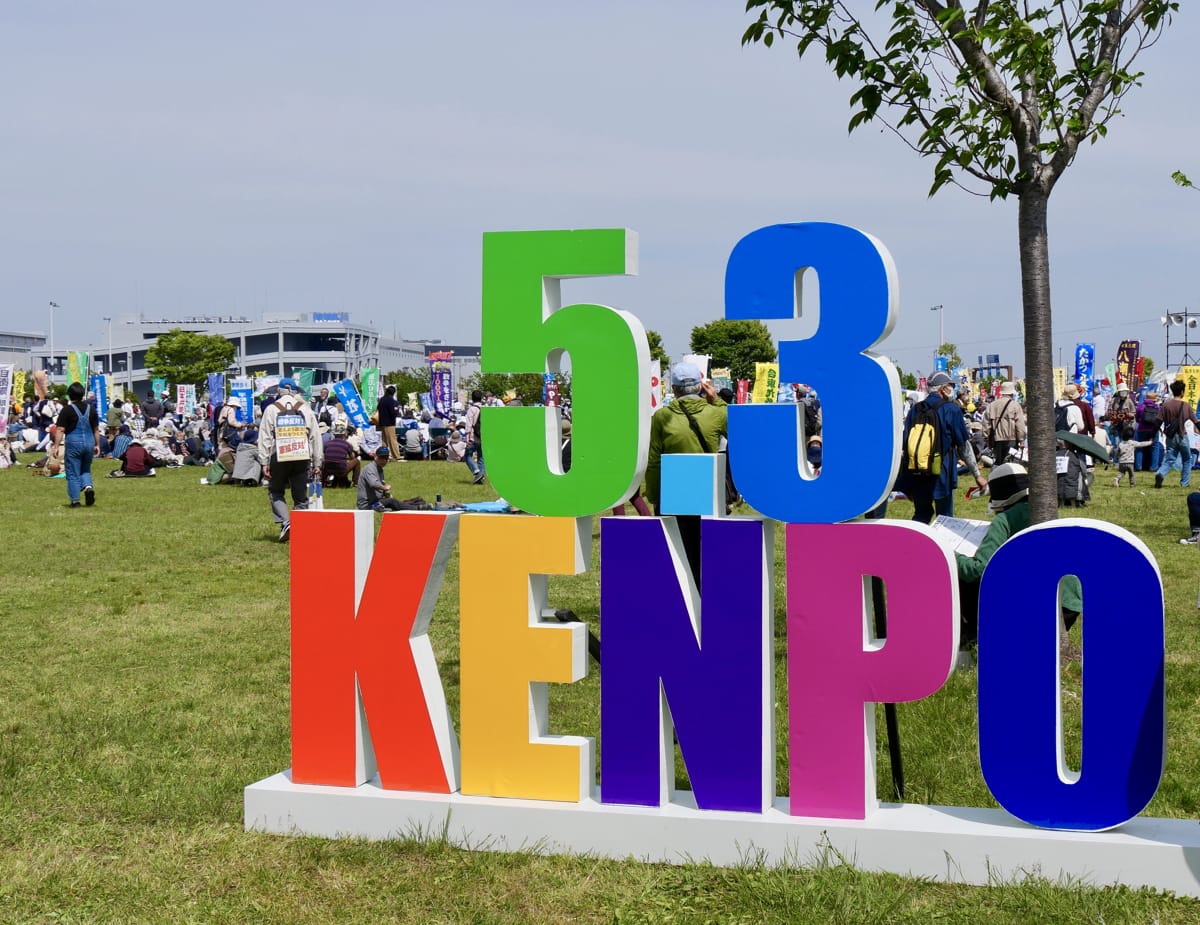Golden Week in Japan is so-named for the coincidence of public holidays starting at the end of April and continuing through until 5 May. In a good year, and in between weekends, you can take almost ten days away from the office. In 2023, although Covid continues to make its presence known, with most masking and distancing recommendations all but lifted, this year was the first in a few years that people could travel and enjoy the break.
And while for most people, it is a time of rest and recreation, every year on 3 May, the day which recognises the promulgation of the Japanese Constitution in 1947, many have gathered in parklands by Tokyo Bay to express support for the pacifist provisions in Article 9 to oppose war. The crowd also made clear this year opposition to the proposed doubling of the defence budget in the face of declining living standards, low wages and increasing cost of living issues.
I have been attending these rallies since 2016, to observe the other side of Japan’s “remilitarisation” debate. Prior to the pandemic, attendance reached an estimated 70,000 people (2019), while this week’s crowd was considerably smaller, at around 25,000. Ongoing concerns over Covid probably contribute to that.
I was particularly interested in observing this year’s protest, the first since former PM Abe Shinzo was shot on the hustings last year and just a couple of months since the passing of two of the leading lights of the anti-war movement, Nobel Laureate Oe Kenzaburo, and musician Sakamoto Ryuichi. Abe was considered the force behind Japan’s renewed defence posturing, whereas Oe and Sakamoto lent their considerable voices to those who sought, not so much the status quo, but an ongoing commitment to Article 9.
In the rush to applaud and enable increased defence cooperation between Japan and Australia, resistance to these developments tends to be overlooked and underreported. In a larger project I am currently writing, I look more closely at this “turn” to defence cooperation and conservative politics between the two countries over the last decade, while seeking to measure the broader domestic costs. The debate over whether to amend Article 9 in Japan is, to some degree, not dissimilar to the Australian discourse over whether or not to embrace a republic or remain a constitutional monarchy. Both debates have at their heart the nation’s identity, and both national debates have strong, perhaps even equally strident, voices on both sides.

In the park by Tokyo Bay on this rather visible day of Constitutional recognition, the atmosphere and participants remain largely unchanged. On the main stage, the leaders of various opposition parties speak to the crowd of peace groups and union members, people from Okinawa whose environment is directly affected by US bases, women’s groups, artists and the occasional inquisitive foreign academic.
Where once their words were directed at Abe, the party leaders this year directed their discontent at Prime Minister Kishida Fumio and his cabinet for doubling the defence budget during a cost of living crisis. (A call that reflects current debate in Australia surrounding AUKUS and submarines.) The call and response from the stage, as participants held posters, carried the same level of passion as it had in previous years.
Each year I attend, I hope to see younger people participating, and while they are there, the crowd is largely older people, some of whom have direct experience of the Second World War, others a bit younger who perhaps carry the stories of their parents and grandparents.
At the end of the speeches, the crowd splits into two to make their way along the roads around the Bay, carrying their banners and singing their protest chants. I asked a few older acquaintances if they were planning to join the march, to which they replied, no, it is too much for them now. But on the ninth day of each month (for Article 9) you will find them at the local train station standing for hours, pursuing their case for maintaining a peaceful Japan.
Kishida has chosen this week to continue his “shuttle diplomacy”, as it is called in the local media, in the lead up to the G7 in Hiroshima later this month. As I write, he is planning a trip to South Korea, not without controversy. Some applaud Japan’s reassertion of its international leadership role in the region (and perhaps beyond) but at the same time, many are cautious as to just how far this defence revamp will go.
The last day of the golden week of public holidays is Children’s Day. This day draws attention to Japan’s future and potential but in quite different ways, particularly as the nation agonises over a declining birth rate and ageing population.
Although seemingly disparate, the two days are inevitably linked. What sort of future will these children have while governments around the world continue to prioritise unfettered military expenditure in the face of more immediate crises that affect people’s lives? The lesson from the week is that it is time to recalibrate the “human” in security matters, to prioritise once again human security, leaving no-one behind, a policy framework which both Japan and Australia can lead cooperation in the region and perhaps beyond.
Disclaimer: I have been invited to speak at local peace movement groups over the years, on Constitutional reform and Australia-Japan relations.
